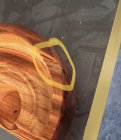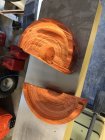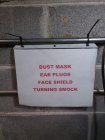-
August 2025 Turning Challenge: Wooden Version of Non-Wood Item! (click here for details) -
Congratulations to David Croxton for "XOXOXO" being selected as Turning of the Week for August 11, 2025 (click here for details) -
Welcome new registering member. Your username must be your real First and Last name (for example: John Doe). "Screen names" and "handles" are not allowed and your registration will be deleted if you don't use your real name. Also, do not use all caps nor all lower case.
You are using an out of date browser. It may not display this or other websites correctly.
You should upgrade or use an alternative browser.
You should upgrade or use an alternative browser.
It blowed up....real good
- Thread starter John Hicks
- Start date
- Joined
- Apr 27, 2004
- Messages
- 9,247
- Likes
- 5,906
- Location
- Lakeland, Florida
- Website
- www.hockenberywoodturning.com
Glad you weren’t hurt
I hope that you did not get hurt. Was that a tenon or expansion?Well, that was "unexpected". A nice chunk of padauk wasted. No cracks, and it still flew apart.
View attachment 32146
I have seen a few bowls where they have another type of wood segmented between two halves of the bowl. You could run both halves over a planner or sander and get them flat and glue a 1" thick flat board in-between the halves and finish turning the bowl. You can make several additional cuts at odd angles and glue different thicknesses of boards in-between the halves and have a multi-segmented bowl with different accent types of wood running through the piece at different angles.
Pen blanks! Glad you're ok.
John Glad you were not injured. If you post some pictures of the side and bottom maybe someone will see something. Just happens I have a 2” x 7” x 7” piece of Padauk with a glue block I’m going to turn today. I’ll be mind full of your experience.
I have seen a few bowls where they have another type of wood segmented between two halves of the bowl. You could run both halves over a planner or sander and get them flat and glue a 1" thick flat board in-between the halves and finish turning the bowl. You can make several additional cuts at odd angles and glue different thicknesses of boards in-between the halves and have a multi-segmented bowl with different accent types of wood running through the piece at different angles.
I think I'll try that. Good idea!
I don't see any marks that look like you had a catch. Some times there are existing cracks that are invisible if you don't have a trained eye. Some times there are existing cracks that you can't see even if you have a trained eye. I always stand out of the line of fire....
robo hippy
robo hippy
Odie
Panning for Montana gold, with Betsy, the mule!
I don't see any marks that look like you had a catch. Some times there are existing cracks that are invisible if you don't have a trained eye. Some times there are existing cracks that you can't see even if you have a trained eye. I always stand out of the line of fire....
robo hippy
Maybe not a catch, per se, but from what I can see, the OP was being extremely hard on the bowl. Just got to be an incredible amount of stress to split it like that, and the evidence shown by the very jagged tool marks are indicating exactly this.
-----odie-----
Photos are deceiving,but it looks like a predrilled (2" ?) center hole with a forstner bit. Looks too deep from view angle. The depth of the hole, plus any kind of inadvertent pressure, could have weakened the wood enough to cause the fracture which is right on the edge (as seen in top photo at 6:00) of the drilled-out hole.
I agree with Odie, it looks like you were being too aggressive for Paduak. It’s super hard and fairly brittle so it needs a more delicate touch when hollowing. It’s fairly easy to break a tenon or recess if too much force is applied.
Was this mounted with a recess for the chuck? If you look closely at the top right the rim is broken and missing a chunk. My guess is you had a catch and broke the rim, this force pulled the bowl enough for the chuck jaws (dovetail jaws?) to split the bottom of the bowl at the recess and due to the nature of padauk it split in half.
Was this mounted with a recess for the chuck? If you look closely at the top right the rim is broken and missing a chunk. My guess is you had a catch and broke the rim, this force pulled the bowl enough for the chuck jaws (dovetail jaws?) to split the bottom of the bowl at the recess and due to the nature of padauk it split in half.
I was wondering if a scraper was being used here? Just like gouges, if you try to take off too much at one time, you can have blow ups. The chip out of the rim could have been from a pre-existing crack, and maybe or maybe not part of the blow up. ALWAYS stand out of the line of fire!!! I did a video on that one as well....
robo hippy
robo hippy
- Joined
- Jan 27, 2005
- Messages
- 13,136
- Likes
- 5,635
- Location
- Dalworthington Gardens, TX
- Website
- pbase.com
Maybe not a catch, per se, but from what I can see, the OP was being extremely hard on the bowl. Just got to be an incredible amount of stress to split it like that, and the evidence shown by the very jagged tool marks are indicating exactly this.
-----odie-----
Odie, I think your analysis is spot on. I was thinking basically the same thing. From the way that the wood fibers appear to be torn I was thinking that the bowl gouge or whatever tool was being used as a scraper and probably also was dull. This then led to a lot of force being used in order for the tool to cut.
I also agree with Greg Norman's assessment.
Photos are deceiving,but it looks like a predrilled (2" ?) center hole with a forstner bit. Looks too deep from view angle. The depth of the hole, plus any kind of inadvertent pressure, could have weakened the wood enough to cause the fracture which is right on the edge (as seen in top photo at 6:00) of the drilled-out hole.
I believe that what appears to be a missing chunk in the picture below might be the catch that you are talking about.

It was my traditional round nose scraper; it caught and the bowl came out of the chuck, flew up and when it hit the floor; that's when it broke in half. Now I'm pretty sure if I would have made the mortise a bit deeper, that wouldn't have happened.I don't see any marks that look like you had a catch. Some times there are existing cracks that are invisible if you don't have a trained eye. Some times there are existing cracks that you can't see even if you have a trained eye. I always stand out of the line of fire....
robo hippy
I never use dull tools! I have a tormek, plus all cryo gouges, so I get them nice and sharp.
- Joined
- Apr 27, 2004
- Messages
- 9,247
- Likes
- 5,906
- Location
- Lakeland, Florida
- Website
- www.hockenberywoodturning.com
It was my traditional round nose scraper; it caught and the bowl came out of the chuck, flew up and when it hit the floor; that's when it broke in half. Now I'm pretty sure if I would have made the mortise a bit deeper, that wouldn't have happened.
don’t get discouraged. We all loose a bowl. Now and then
The better we get at turning the less often it happens unexpectedly.
1. When we turners make a catch happen with a scraper inside a bowl it is usually one of two things we do wrong.
A. Let the bevel contact the wood which causes the wood to drive into the tool. Once the wood drives into the tool something has to break unless the lathe stalls. Keep the toolmrest above center and use the tool with the tip pointed down to center. This keeps the bevel off the wood,
B. The scraper is pushed toward the end grain. The endgrain “climbs onto the tool” because the tool sort of splits the wood. Once this happens something has to break unless the lathe stalls.
2. for almost all my bowls I use either a tenon in a Chuck or glue block on a faceplate.
If you are Set on using recesses that’s your choice and they do work.
My first chuck only expanded so I had to do recesses. Lots of negatives for me versus a tenon or glueblock.
I almost never do a recess now. If I don’t have the wood for a tenon I use a glueblock.
3. It takes a lot of skill to use a scraper to hollow bowls. When I first started turning I hollowed quite a few bowls with a scraper didn’t get catches but never got really really good with the scrapers. If you want to learn to use scrapers, Watch Reed Gray’s videos.
I much prefer using a bowl gouge. My students usually learn to effectively use a bowl gouge within a few hours.
And they use the round nose scrapers just to clean up the bottom center of the bowls if needed.
Last edited:
Odie
Panning for Montana gold, with Betsy, the mule!
It was my traditional round nose scraper; it caught and the bowl came out of the chuck, flew up and when it hit the floor; that's when it broke in half. Now I'm pretty sure if I would have made the mortise a bit deeper, that wouldn't have happened.
(I see Al's post, as I type this response......some good advice here.)
One thing to consider here, John......is scrapers can produce some really nasty catches if the tool rest isn't continually moved inward as you remove stock from the interior of the bowl. Not only that, but the danger can be compounded pretty quickly if you break concentration for only an instant, and present the scraper in a plunge mode without the base of the tool making full side-to-side contact with the tool rest. This is very easily done, and I've had some bad catches this way......concentration for what you are doing is paramount!
Another danger factor can be the angle of presentation......especially if there is a long overhang of the tool over the tool rest.......
I haven't stopped using scrapers for removing stock fast, but only for initial bulk stock removal. Once I get anywhere near the final depth, I switch over to a gouge for a more refined cut. you can remove stock pretty fast with a gouge, but not quite as fast as a heavy duty scraper using a plunge cut technique.......
-----odie-----
Last edited:
- Joined
- Apr 27, 2004
- Messages
- 9,247
- Likes
- 5,906
- Location
- Lakeland, Florida
- Website
- www.hockenberywoodturning.com
you can remove stock pretty fast with a gouge, but not quite as fast as a heavy duty scraper using a plunge cut technique..
this is maybe true - maybe false.
whether you can work faster with a gouge or a scraper depends on many factors
The grind on your gouge, your skill with the gouge, your skill with the scraper, the size of the bowl You are turning and the type of wood you are turning.
Smaller shallow bowls are easy to do with a scraper. Larger deeper bowls more difficult to do with a scraper.
I wouldn’t even try to use a scraper on a natural edge bowl.
Most of the production bowl turners today use a sideground gouge. Production speed drives their choices of tools. If they could make more bowls using as scraper they would.
Last edited:
One more thing to remember, wood is compressible so check the chuck several times after you mount it for any sign of looseness. Ive had work that had to be retightened four or five times while working on it due to that fact.
Odie, I think your analysis is spot on. I was thinking basically the same thing. From the way that the wood fibers appear to be torn I was thinking that the bowl gouge or whatever tool was being used as a scraper and probably also was dull. This then led to a lot of force being used in order for the tool to cut.
I also agree with Greg Norman's assessment.
I believe that what appears to be a missing chunk in the picture below might be the catch that you are talking about.
View attachment 32157
I was referring to this spot. It looks like there is a crack down the side where this piece is missing.

Odie
Panning for Montana gold, with Betsy, the mule!
this is maybe true - maybe false.
whether you can work faster with a gouge or a scraper depends on many factors
The grind on your gouge, your skill with the gouge, your skill with the scraper, the size of the bowl You are turning and the type of wood you are turning.
Smaller shallow bowls are easy to do with a scraper. Larger deeper bowls more difficult to do with a scraper.
I wouldn’t even try to use a scraper on a natural edge bowl.
Most of the production bowl turners today use a sideground gouge. Production speed drives their choices of tools. If they could make more bowls using as scraper they would.
Yeah, I think that's a fair statement, Al.........
We'll put it this way......It's generally true for my kind of turning, and even so, it may not be true for all wood species, grain orientation, general resistance to the cut, and levels of MC. Because of that, it's a significant consideration to note that I do not choose the same woods that a production turner does. Another thing to consider is my lathe has a 1 1/2 hp motor, and that will make a difference, when comparing performance capabilities of what is possible with those who have more horsepower to work with. ....
-----odie-----
Definitely! Just wait until the chuck comes off! I check the set screws on the adapter and the chuck a few times during turning.One more thing to remember, wood is compressible so check the chuck several times after you mount it for any sign of looseness. Ive had work that had to be retightened four or five times while working on it due to that fact.
Or hop on I5 and go have a lesson with Reed. (Robo Hippy) OK, it's a 4 hour drive, but nearly impossible to get lost. In a half day, you would learn 2 years worth of figuring it out on your own!3. It takes a lot of skill to use a scraper to hollow bowls. If you want to learn to use scrapers, Watch Reed Gray’s videos.


